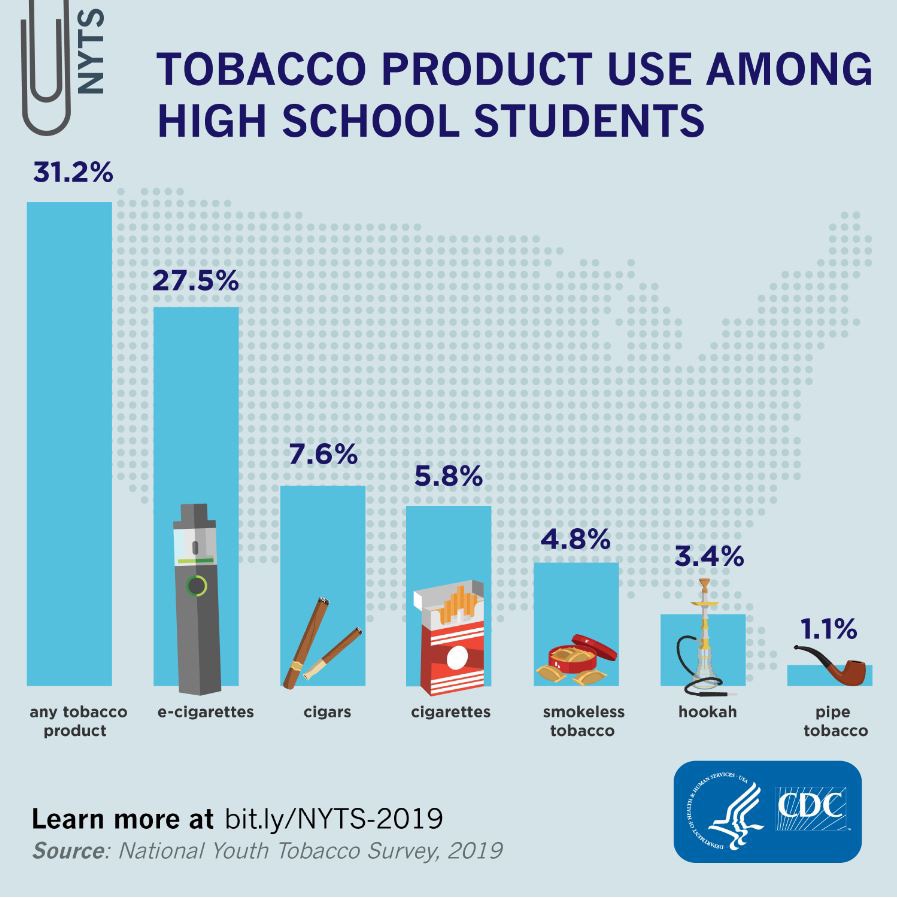
6.2 Million middle and high school students used tobacco products in 2019
E-cigarettes most commonly used tobacco product
Press Release
About 6.2 million U.S. middle and high school students were current (past 30-day) users of some type of tobacco product in 2019, according to new National Youth Tobacco Survey (NYTS) data released in today’s Morbidity and Mortality Weekly Report.
The survey found that about 1 in 3 high school students (4.7 million) and about 1 in 8 middle school students (1.5 million) are current tobacco users.
For the sixth year in a row, e-cigarettes were the most commonly used tobacco product among high school (27.5%) and middle school students (10.5%). Tobacco products used by middle and high school students were not limited to e-cigarettes, but also included cigars, cigarettes, smokeless tobacco, hookahs, and pipe tobacco.
“Our Nation’s youth are becoming increasingly exposed to nicotine, a drug that is highly addictive and can harm brain development,” said CDC Director Robert R. Redfield, M.D. “Youth use of any tobacco product, including e-cigarettes, is unsafe. It is incumbent upon public health and healthcare professionals to educate Americans about the risks resulting from this epidemic among our youth.”
Many of these students are also using more than one tobacco product. Among current tobacco product users, about 1 in 3 middle and high school students (2.1 million) used two or more tobacco products. Among youth, symptoms of nicotine dependence are increased in multiple tobacco product users compared with single tobacco product users.
Data on youth tobacco-product use
In collaboration with the U.S. Food and Drug Administration, CDC analyzed data from the 2019 NYTS. NYTS has been conducted periodically during 1999–2009 and annually since 2011. From 1999 through 2018, NYTS had been conducted in middle and high schools via paper and pencil questionnaires. In 2019, NYTS, for the first time, was administered in schools using tablet computers.
Key findings:
- Among high schoolers, e-cigarettes were the most commonly used (27.5%) tobacco product, followed by cigars (7.6%), cigarettes (5.8%), smokeless tobacco (4.8%), hookahs (3.4%), and pipe tobacco (1.1%).
- Among middle schoolers, e-cigarettes (10.5%) were also the most commonly used tobacco product, followed by cigars (2.3%), cigarettes (2.3%), smokeless tobacco (1.8%), and hookahs (1.6%).
- Among middle and high school students overall, the most commonly used tobacco product combination among multiple tobacco product users was e-cigarettes and cigars (17.2%), followed by e-cigarettes and cigarettes (13.3%), and e-cigarettes and smokeless tobacco (9.8%).
- In 2019, among middle and high school students, more than half (57.8%) of current tobacco product users reported seriously thinking about quitting all tobacco products. In addition, 57.5% reported they had stopped using all tobacco products for one or more days because they were trying to quit. Increasing successful quit attempts could complement prevention efforts to reduce tobacco product use among youths.
“We are fully committed to preventing children from using harmful tobacco products, including e-cigarettes, and will continue to develop policies that will achieve that objective as soon as possible,” said Admiral Brett Giroir, M.D., HHS assistant secretary for health and acting FDA commissioner. “In addition, we will continue taking other actions to address this shocking epidemic of youth use, including aggressive enforcement and compliance efforts and evidence-based public education – which includes investing in campaigns to educate youth about the many dangers of e-cigarette use including addiction, behavioral disorders, and other health risks.”
Many factors influence youth tobacco product use
Multiple factors influence youth initiation and use of tobacco products. Today’s report assessed several of these factors, including tobacco product advertising and promotions, flavored tobacco products, curiosity, and misperceptions of harm.
- Tobacco product advertising and promotions: In 2019, nearly 9 in 10 middle and high school students (22.9 million) reported exposure to tobacco product advertisements or promotions from at least one source.
- Flavored tobacco products: Nearly 7 in 10 (4.3 million) middle and high school students who currently use tobacco reported use of flavored tobacco products in 2019.
- Curiosity: Among students who reported ever having tried e-cigarettes, the three most common reasons for use were “I was curious about them” (55.3%), “friend or family member used them” (30.8%), and “they are available in flavors, such as mint, candy, fruit, or chocolate” (22.4%). Among students who never used e-cigarettes, 39.1% were curious about using e-cigarettes and 37.0% were curious about smoking cigarettes.
- Misperceptions of harm: Among all students, perceiving no harm or little harm from intermittent tobacco product use (use on some days but not every day) was 28.2% for e-cigarettes, 16.4% for hookahs, 11.5% for smokeless tobacco products, and 9.5% for cigarettes.
What more can be done about youth tobacco use?
Comprehensive, sustained, evidence-based tobacco control strategies, combined with FDA regulation of tobacco products, are important for preventing and reducing tobacco product use among U.S. youths.
Given the evolving variety and availability of tobacco products, surveillance for all forms of youth tobacco product use and associated factors is important to inform action at the national, state, and community levels.
To learn more about today’s surveillance summary, visit www.cdc.gov/mmwr. To learn more about quitting and preventing youth from using tobacco products, visit www.BeTobaccoFree.gov.























.png)











No hay comentarios:
Publicar un comentario